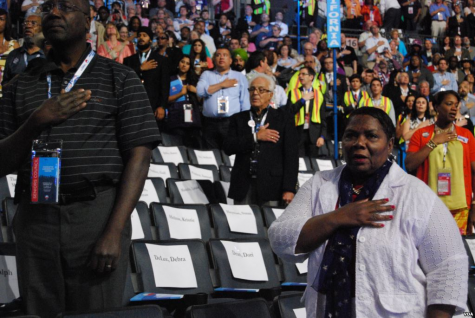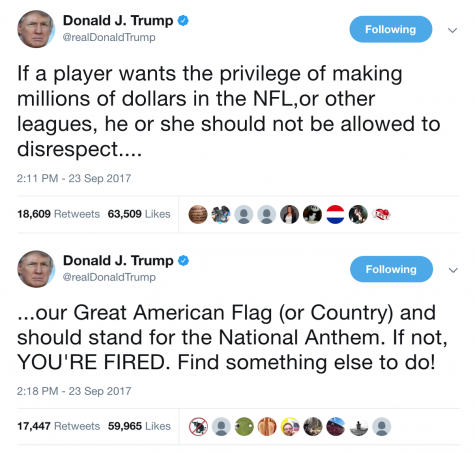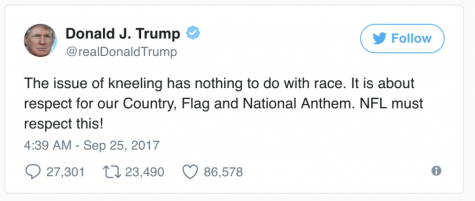Sit or Stand?
Do Tahoma Students have to stand for the Pledge of Allegiance?
February 8, 2018
It’s a normal Friday morning, students are piling into the school, exhausted but ecstatic because it’s the last day of school before the weekend begins. A student, just as tired and excited as everyone else, goes into the classroom and sits down. Soon the announcements begin and students are asked to stand for the Pledge of Allegiance, except the student doesn’t stand. Since the student doesn’t stand, the teacher gets mad and kicks them out of the classroom, in a short matter of time the student’s excitement turns into a nightmare.
America, land of the free, in other words, that means Americans constantly arguing with each other about where to draw the line with the number of freedoms citizens should have access to. Americans have been not standing for the Pledge of Allegiance and National Anthem to protest the injustice that is happening around the country currently. Students around the country are starting to not stand for the Pledge of Allegiance when asked to do so.
However, people are at odds about whether or not it is their right to do so, or if it is disrespectful.
The Pledge of Allegiance is something people have been doing for years and years. People are taught the Pledge of Allegiance as young as kindergarten and they continue to do it throughout their lives. From school to events to sporting events, the Pledge of Allegiance is recited. However, people are starting to wonder if they should have to stand.

Americans have always been conflicted over the issue of whether or not sitting during the National Anthem and Pledge of Allegiance is considered disrespectful. Even though people have always clashed about the issue, it’s not been an issue thrust into the national spotlight. On September 23rd, 2017 President Donald Trump tweeted multiple times about how players for the National Football League should stand for the National Anthem, demanding respect for the flag and chastising players citing if athletes are making millions they should stand or be fired. These tweets caused mixed emotions for citizens all around the country, some say he is right and others say it’s an athlete’s exercise of free speech.


Students have started to bring the same mentality into their schools and have started to sit for the Pledge of Allegiance within their schools causing more controversy to come up because some teachers and students find it disrespectful. This asks the question, do students have to stand for the flag during the Pledge of Allegiance?
In 1940 The Minersville School District v. Gobitis case occurred. A ten-year-old boy from Pennsylvania refused to salute for the flag during the Pledge of Allegiance saying it went against his religious beliefs. The course went all the way to the Supreme Court where they ruled against the boy saying that the flag required respect. However, just three years later the Supreme Court had a different outlook.
In 1943 the West Virginia State Board of Education v. Barnette occurred. The case involved young boy Walter Barnette when he decided to not stand for the Pledge of Allegiance during school saying it was against his beliefs but the school was furious that it had happened. The Supreme Court ruled in favor of Barnette saying it violated the first and fourteenth amendment.
The first amendment is that Congress can make no law prohibiting a person’s exercise to free speech. The fourteenth amendment is that no state shall make a law that restricts a person’s privileges or rights of being an American citizen. The Supreme Court ruled that by making Barnette it violated both his rights and his rights of being an American citizen.
The same thing is happening in America today. A seventeen-year-old named India Landry was expelled for not standing for the flag in early October, she did not stand because she was protesting police brutality and said the flag went against everything she believed in. School officials told her that she was not in the NFL. However, in 1943 the Supreme Court ruled that students could not force students to say or stand for the Pledge of Allegiance.
Tahoma students have started to start sitting for the pledge as well. Tahoma students are given a planner at the beginning of the year that outlines the rules and regulations that students are required to follow. The outline of the rules does not outline anything about students standing for the pledge or not.
Junior Alyse Bell said “Yes” to the question asking whether or not she believes people will judge her for not standing.
Senior Trevor Lind said that he thinks that certain teachers would look at their students differently and that it depends on the teacher.
Standing or sitting for the pledge seems like it’s a simple as standing or not, but there is much more history or reasons that go into a person not standing, such as protesting the injustices going on around the country, or reasons for standing such as feeling teachers and classmates will look at them differently. The simple answer to the question, do students have to stand for the pledge, is no they don’t for the supreme court ruled that it violated a person’s first and fourteenth amendments.



Cameron Thomson • Feb 14, 2018 at 1:59 pm
Being from out of this state, I don’t want to pledge allegiance to a country I’m not from. I just don’t think I should have to be saying a pledge to a country that I am not from.